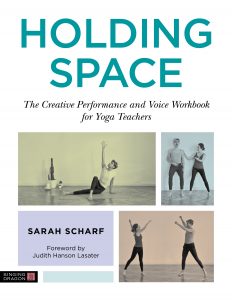 Sarah Scharf, MFA is a yoga teacher, author of the upcoming book, Holding Space: The Creative Performance and Voice Workbook for Yoga Teachers and theatre artist. She holds an MFA in Physical Theatre and has completed multiple training courses in Yoga of various styles. In London she taught at Triyoga – the largest studio in Europe – and worked as a mentor for the Yogacampus Teacher Training. She runs popular workshops and training on voice work and performance skills for yoga teachers, and works as a movement director and teaching artist for theatre. She is an American currently living in Vienna.
Sarah Scharf, MFA is a yoga teacher, author of the upcoming book, Holding Space: The Creative Performance and Voice Workbook for Yoga Teachers and theatre artist. She holds an MFA in Physical Theatre and has completed multiple training courses in Yoga of various styles. In London she taught at Triyoga – the largest studio in Europe – and worked as a mentor for the Yogacampus Teacher Training. She runs popular workshops and training on voice work and performance skills for yoga teachers, and works as a movement director and teaching artist for theatre. She is an American currently living in Vienna.
Improvisational theatre has a rule that is not to be broken under any circumstances: Yes, And. The principle is simple: whatever is happening must be accepted before we add to it. The pandemic has made this principle my greatest ally. It helps me acknowledge the challenge of uncertain work income, the inability to plan or make decisions with a full picture and the intensity of grief that has rocked me as our world has changed so quickly. At a recent workshop I gave, a longtime yoga and meditation teacher commented that improvisation is very much like mindfulness. I totally agree. Mindfulness as a practice of being aware of what is present, what is actually happening versus being stuck in our thoughts and expectations, is the basis of improvisation.
The “new normal”
Teachers of all types have suddenly been asked to teach through new mediums. People with different types of jobs are zooming and working remotely. Those of us who have work that can be moved online are lucky, yet the transition has been rocky for a lot of us. My background in theatre and many years of teaching experience have really helped me to adapt. Most of this blog is adapted from my upcoming book Holding Space:The Creative Performance and Voice Workbook for Yoga Teachers. We don’t need to be trained actors to communicate clearly and effectively through screens. We do need to embrace improvisation, allow for the learning curves and be extra kind to ourselves.
Getting familiar with being honest with yourself, saying yes acceptingly to your own feelings, is step one in being present to find the And. The And is what you do with the situation you are in. What you add to the scene to drive the action forward. The And is how you react.
Being good at improvisation is just like anything else, you can get better the more you do it – much like holding space. Being in the unknown is an essential part of life, during this pandemic it is simply more palpable. None of us really knows what is going to happen next. I find comfort in remembering that this is true for everyone. Improvisation can be as simple as dancing, or as complex as getting a group of friends, colleagues or students on a meeting and making up a story line by line. A fun solo improv game is to turn the sound off on a movie or TV show and make up the dialogue yourself. It might feel weird as you start but you might surprise yourself with creativity. Being comfortable with improvising will help when there are any tech fails or delays, which invariably there are.
When you go to film a video for recording or livestream think of it like any class or meeting where you might be holding space: who is your audience and what do you want to communicate? Remember that nerves are normal, don’t let them trick your brain into thinking you are not prepared or capable! Find the time to relate to your feelings rather than repress them. No one is expecting a perfectly produced piece of content right now, we are all finding our way so this is a chance to try on the medium without perfection in mind.
Doing some vocal warm ups and having clear diction is even more important when the audience will be listening to you through a device. Many people have a feeling of stiffness or rigidity when they get in front of a camera. You can see this in a lot of videos when people are not trained for camera work or used to it. Focus on movements and breath techniques that help loosen you up before you start so that you can really embody enough ease for your personality to come through and prepare you for holding space (virtually). Whenever possible work with people that help you to laugh when there is any technical issue (there always are technical issues). Humour is great for breaking the ice and lightening the mood, take risks with your jokes and allow moments where you can laugh at yourself. Allow yourself to react as much as you can with your expressions and gestures, again a warm-up will help. Here are few that you can try:
Yawn it out
I heard the legendary Morgan Freeman say in an interview that he thinks yawns are the best warm-up for the voice. Sneak in a yawn whenever you can to discreetly open the throat area and help your pitch stay optimal. When you can’t do more of a warm-up, at the very least give yourself a big yawn.
Tongue Twisters
Break out your favourites from primary school and play with how you can change your volume, speed and intonation. This gets the mouth elastic and ready to speak.
My favourite:
It takes time to untangle twenty-two tutus!
Body Undulations
From standing, find a steady breath. Imagine you are seaweed. Allow a wave to pulse through you from head toe. Exhale and roll down the spine like a moving forward fold, then bend the knees and roll back up with a strong impulse and a sense of rhythm. Do not go for precision of spinal rolls, go for a flowing movement that is breath initiated. This gets the blood pumping and helps release tension from the whole body.
Self-massage
Touch is a great way to release tension, and self-massage is free and easy. Start by working on your shoulders if this area is most familiar to you for receiving massage. Knead the trapezius shoulder muscle as firmly as possible without creating pain. Be gentle as you work on the neck and avoid the front of the throat for now. With clean hands reach your first two fingers into the mouth and use your thumb on the outside of the cheek. Reaching toward the back of the jaw, find the muscle in the cheek—it is usually like a small button. Press gently with thumb and fingers to work the muscle.

Jaw massage
Dig your fingertips into the grooves at the back of your jaw where it hinges. Make circles along the jaw muscles. Open and close the jaw while giving pressure. Get into the areas that are tight respectfully. Again, avoid going too deeply too quickly and make this a regular practice rather than a strong one.

Jaw release
This is one of my all-time favorites. It has a tendency to make us giggle, because it involves funny and involuntary sounds. However, if you are laughing or smiling the tension in your face will block the exercise from being effective. So, laugh it out first and when you are able to proceed without a tense face give it a try.
Clasp your hands firmly together, interlacing your fingers fully. Hold the hands in front of your chest with bent elbows. Relax your face until your jaw hangs open. As you exhale with sound begin to shake your arms so vigorously that your jaw flaps up and down. Let the flapping continue as you exhale with sound, so the combination of flapping and sound vibration creates a full release for your jaw and throat. Enjoy the funny sounds that will escape as you allow them to come forth unrestrained by judgements.
As like anything else, the more you work with this medium the more comfortable you will get with it. Any feelings that seem amplified by the camera were probably there when you began teaching groups or did anything new. Using exercises that guide you into a space of confidence are vital. Affirmations are useful. Practices for relaxation are helpful the day before an event, they can work against you if you are too relaxed when you begin and your energy doesn’t hold people’s attention.
Language: An exercise in finding the essential
Our words should be pared back to the essential and spoken without apology. Try this exercise to practice getting your words clearer and more precise—with a friend preferably, but it is also possible with your recording device. This is a good one to do at lunch! You can listen to your recording and make your lunch following your own instructions.
Instruct someone on how to make your favourite sandwich. Be precise—how much of each ingredient, the order in which to place the fillings…
Now do it again with fewer words. In particular use fewer filler words and keep using the words that are clearest.
And again, even fewer words!
Activate Your Verbs
A quick and effective technique for your teaching language is to recognise when you are using active versus passive verbs. Active verbs are the best way to get people to embody actions and movements. They inspire action and are easier to incorporate as a command or direction than a passive verb. Take some time before you give a presentation or teach on screen to list active verbs you can use to make your instruction or talk clearer.
INCLUSIVE LANGUAGE = SAFE LEARNING ENVIRONMENT
This is more than recognising that pronouns should be used sensitively and LGBTQ, disabled people and people of all walks of life deserve to be welcomed and exposed to your teaching. The heart of finding and using inclusive language is about not assuming that your students have the same background as you and acknowledging your unique perspective rather than staying blind to privilege.
 Holding Space
Holding Space
The Creative Performance and Voice Workbook for Yoga Teachers
Sarah Scharf, Foreword by Judith Hanson Lasater
Holding Space provides yoga teachers with the skills they need to understand how to care for and improve their voices technically, as well as how to express themselves authenticity and effectively as a teacher. Being able to give instruction clearly and with emotional intelligence is part of the personal development that each yoga teacher goes through. This book offers instruction, support and ideas on how to embark on the journey of yoga teaching with greater confidence and mindfulness.
Learn more about Sarah’s work at www.sarahscharf.com